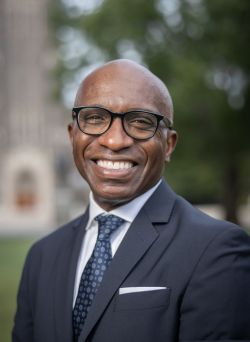
Q&A: Continuing the March for Racial Equity

The 2021 Duke Campus Climate Survey, the first survey of its kind that measured experiences of university community members, revealed that among 12,751 respondents, more than half of Duke’s Black, Hispanic, Asian, female and LGBTQ+ community members reported experiencing microaggressions in the
past year.
Whether through Duke University Health System’s “Moments to Movement” initiative or the university’s Racial Equity Advisory Council, Duke has been working to create lasting change around racial equity, diversity, and inclusion.
As Duke’s second century dawns, Assistant Vice President for Diversity, Equity and Inclusion Leigh-Anne Royster and Duke University Health System Vice President and Chief Employee Experience Officer Ian Lee Brown shared thoughts on Duke’s progress.

How does the university draw upon its history of systemic racial injustice to inform efforts and combat inequality?
Royster: Like many institutions of higher education, Duke has a history with systemic racial injustice.
We also have a unique position as a private institution in the South, with the kind of resources and reach we have, to lead in reckoning with racial equity work.
There are opportunities for us to allocate resources and develop relationships in ways that reconcile and account for our participation with racial injustice.
It’s incumbent upon us to reflect at the Centennial and do everything we can to be accountable for our participation in the past, while understanding that we’re still participating in ways we may only see when we’re able to evaluate at some time in the future.

What key initiatives has Duke University Health System implemented to address inequity?
Brown: When I came here in 2022, I learned about significant opportunities from our Moments to Movement journey where leaders and team members spoke about racism, social justice, and health inequalities, and about work groups which assessed the state of diversity, equity, inclusion and belonging across our system.
Now, we’ve built a strategy for diversity, equity, inclusion and belonging focused on optimizing the human experience here at Duke.
We’re focusing on equitable hiring, retention, and promotion; inclusive leadership development; and maintaining strong partnerships with our nine employee affinity groups.
The population around Duke is getting more diverse, so I want everyone who walks through the doors of Duke Health to feel like they belong.
What notable observation do you identify from the period after 2020?
Royster: People describe decentralization at Duke as a challenge. There are certainly challenges related to decentralization. However, one core strength of our community is that, perhaps because of that decentralization, there is accountability across the enterprise.
We don’t feel like racial equity work only happens in one office or department. I’ve found that across the university and health system, people believe the accountability for racial equity work is theirs. I see it from IT to clinical settings to facilities to the classroom. There’s no way this work happens successfully without everyone being invested and seeing their place in it.
Do you have a story you would like for us to cover for the Centennial year? Send ideas and photographs through our story idea form or write working@duke.edu.
Follow Working@Duke on X (Twitter), Facebook, and Instagram.